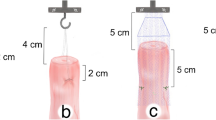Abstract
Introduction
Pectopexy, a laparoscopic method for prolapse surgery, showed promising results in previous transient testing by this group. It was shown that a single suture, yielding an ultimate load of 35 N, was equivalent to continuous suturing. This was demonstrated in an in vitro cadaver study. This transient data were used to establish an elastic stress–strain envelope. It was now possible to proceed to dynamic in vitro analysis of this surgical method to establish time to functional stability.
Methods
Cyclic testing of this fixation method was performed on human female embalmed cadaver (cohort 1) and fresh, non-embalmed cadaver (cohort 2) pelvises. The testing envelope was 5–25 N at a speed of 1 mm/s. 100 load regulated cycles were applied.
Results
100 cycles were completed with each model; no overall system failure occurred. Steady state, i.e., functional stability was reached after 14.5 (± 2.9) cycles for the embalmed group and after 19.1 (± 7.2) cycles for the non-embalmed group. This difference was statistically significant p = 0.00025.
Conclusion
This trial showed in an in vitro cyclic testing of the pectopexy method that functional stability may be achieved after no more than 19.1 cycles of load exposure. When remaining within the established load envelope of below 25 N, patients do not need to fear global fixation failure. Testing did demonstrate differences in non-embalmed and embalmed cadaver testing. Embalmed cadaver testing tends to underestimate time to steady state by 26.3%.

Similar content being viewed by others
References
Banerjee C, Noe KG (2011) Laparoscopic pectopexy: a new technique of prolapse surgery for obese patients. Arch Gynecol Obstet 284:631–635
Alkatout I, Mettler L, Peters G, Noe G, Holthaus B, Jonat W et al (2014) Laparoscopic hysterectomy and prolapse: a multiprocedural concept. JSLS 18:89–101
Huber SA, Northington GM, Karp DR (2014) Bowel and bladder dysfunction following surgery within the presacral space: an overview of neuroanatomy, function, and dysfunction. Int Urogynecol J 26:941–946
Lee RK, Mottrie A, Payne CK, Waltregny D (2014) A review of the current status of laparoscopic and robot-assisted sacrocolpopexy for pelvic organ prolapse. Eur Urol 65:1128–1137
Maher C, Baessler K, Glazener CM, Adams EJ, Hagen S (2004) Surgical management of pelvic organ prolapse in women. Cochrane Database Syst Rev 4:CD004014
Nygaard IE, McCreery R, Brubaker L, Connolly A, Cundiff G, Weber AM et al (2004) Abdominal sacrocolpopexy: a comprehensive review. Obstet Gynecol 104:805–823
Siddiqui NY, Grimes CL, Casiano ER, Abed HT, Jeppson PC, Olivera CK et al (2015) Mesh sacrocolpopexy compared with native tissue vaginal repair: a systematic review and meta-analysis. Obstet Gynecol 125:44–55
Tahaoglu AE, Bakir MS, Peker N, Bagli I, Tayyar AT (2018) Modified laparoscopic pectopexy: short-term follow-up and its effects on sexual function and quality of life. Int Urogynecol J 29:1155–1160
Cezarino BN (2017) Editorial comment: laparoscopic pectopexy: initial experience of single center with a new technique for apical prolapse surgery. Int Braz J Urol 43:910
Kale A, Biler A, Terzi H, Usta T, Kale E (2017) Laparoscopic pectopexy: initial experience of single center with a new technique for apical prolapse surgery. Int Braz J Urol 43:903–909
Sauerwald A, Niggl M, Puppe J, Prescher A, Scaal M, Noe GK et al (2016) Laparoscopic pectopexy: a biomechanical analysis. PLoS ONE 11:e0144143
Thelen S, Schneppendahl J, Baumgartner R, Eichler C, Koebke J, Betsch M et al (2013) Cyclic long-term loading of a bilateral fixed-angle plate in comparison with tension band wiring with K-wires or cannulated screws in transverse patella fractures. Knee Surg Sports Traumatol Arthrosc 21:311–317
Hackl M, Wegmann K, Ries C, Lappen S, Scaal M, Muller LP (2017) Annular ligament reconstruction with the superficial head of the brachialis: surgical technique and biomechanical evaluation. Surg Radiol Anat 39:585–591
Thelen S, Betsch M, Schneppendahl J, Grassmann J, Hakimi M, Eichler C et al (2013) Fixation of multifragmentary patella fractures using a bilateral fixed-angle plate. Orthopedics 36:e1437–e1443
Thelen S, Schneppendahl J, Jopen E, Eichler C, Koebke J, Schonau E et al (2012) Biomechanical cadaver testing of a fixed-angle plate in comparison to tension wiring and screw fixation in transverse patella fractures. Injury 43:1290–1295
Wild M, Eichler C, Thelen S, Jungbluth P, Windolf J, Hakimi M (2010) Fixed-angle plate osteosynthesis of the patella—an alternative to tension wiring? Clin Biomech (Bristol, Avon) 25:341–347
Wild M, Thelen S, Jungbluth P, Betsch M, Miersch D, Windolf J et al (2011) Fixed-angle plates in patella fractures - a pilot cadaver study. Eur J Med Res 16:41–46
Zimkowski MM, Rentschler ME, Schoen J, Rech BA, Mandava N, Shandas R (2013) Integrating a novel shape memory polymer into surgical meshes decreases placement time in laparoscopic surgery: an in vitro and acute in vivo study. J Biomed Mater Res A 101:2613–2620
Zimkowski MM, Rentschler ME, Schoen JA, Mandava N, Shandas R (2014) Biocompatibility and tissue integration of a novel shape memory surgical mesh for ventral hernia: in vivo animal studies. J Biomed Mater Res B Appl Biomater 102:1093–1100
Eichler C, Schell J, Uener J, Prescher A, Scaal M, Puppe J et al (2016) Inframammary fold reconstruction: a biomechanical analysis. Plast Reconstr Surg Glob Open 4:e634
Author information
Authors and Affiliations
Contributions
AS: project development and manuscript writing. LL: project development, data collection, and manuscript writing. DR: manuscript writing/editing. AP: data collection. MS: data collection. GKN: project development manuscript writing/editing. KW: data collection. DRB: manuscript writing/editing. CE: project development, data collection, and manuscript writing.
Corresponding author
Ethics declarations
Conflict of interest
The authors declare no conflict of interest.
Ethical approval
This article does not contain any studies with human participants or animals performed by any of the authors.
Additional information
Publisher's Note
Springer Nature remains neutral with regard to jurisdictional claims in published maps and institutional affiliations.
Rights and permissions
About this article
Cite this article
Sauerwald, A., Langer, L., Ratiu, D. et al. Laparoscopic pectopexy: a follow-up cyclic biomechanical analysis determining time to functional stability. Arch Gynecol Obstet 299, 1337–1343 (2019). https://doi.org/10.1007/s00404-019-05117-9
Received:
Accepted:
Published:
Issue Date:
DOI: https://doi.org/10.1007/s00404-019-05117-9




